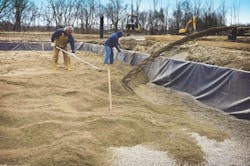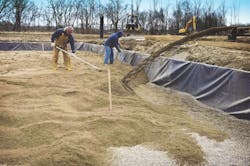Birds in the Sand
In 2000, a small, family-owned turkey processing plant faced closure. The permitted lagoon system that had treated Whitewater Processing Inc. wastewater for decades created odors and threatened the groundwater. Pretreating the wastewater and constructing a sewer extension to the municipal treatment plant in the neighboring city of Harrison, Ohio, was too expensive for the company that processed 7,000 birds per day. The third-generation meat processor also was concerned about its 100 employees. The owner sought a way to treat the high-strength, high-fat content wastewater in an affordable way.
Now in 2017, the processing plant operates at full capacity, but it never connected to the city treatment plant. Instead, working with Ohio State University (OSU), Whitewater Processing developed and constructed its own, onsite treatment system called a sand bioreactor. The simple technology, designed in the Department of Food, Agricultural and Biological Engineering at OSU, grew from a research program focused on treating food processing wastewater.
Civil and environmental engineers have mastered how to treat domestic sewage in municipal treatment plants. But meat processing wastewater that is five times stronger with a 100 times higher fat content is not a good match for systems designed to treat domestic wastewater. Pressure is placed on the food processors to change their wastewater through expensive pre-treatment processes and are often assessed extra surcharges to recover the cost of treating the high organic matter content wastewater.
The OSU research program has a special philosophy: “If nature creates it, nature can degrade it.” Therefore, the research focused on treatment systems that would naturally degrade fat. Working with turkey processing wastewater from Whitewater Processing, Karen Mancl, professor for Ohio State University, developed a sand bioreactor system in the laboratory. With permission from the Ohio Environmental Protection Agency (Ohio EPA), Whitewater Processing staff constructed a small pilot plant. Based on the success of both the lab and pilot studies, Ohio EPA issued a National Pollutant Discharge Elimination System (NPDES) and installation permit to Whitewater Processing in 2010.
The 4-acre system was simple to design and construct. The company built the 200,000 gal per day (gpd) plant itself. Because the plant was constructed as 12 82-ft-by-180-ft bioreactor cells, the plant could treat wastewater after the first six cells were completed in August 2012. The remaining bioreactors were brought online as they were constructed.
The reaction of the neighbors was especially revealing to its effectiveness. A subdivision of homes lies across the street from the treatment plant. The company owner was concerned about the dust created during construction, and to thank the neighbors for their patience, he visited each home in November and offered them a turkey as an apology for the inconvenience of the construction. Neighbors expressed concern about the potential smell coming from the plant after it came online. The owner happily informed them the system had been treating wastewater for three months and the special OSU design created no odor.
Weighing System Cost
Treatment plants often assess surcharges to dischargers of high-strength wastewater. In the case of the Harrison, Ohio, treatment plant, the first quote to Whitewater Processing was $10.56 per 1,000 gal.
Before discharge to the municipal treatment plant, the wastewater must first be pre-treated to reduce the fat, oil and grease (FOG). This would require a dissolved air flotation unit, extended aeration, a clarifier and sludge holding. The cost to construct the pretreatment unit and connect to the city treatment system was estimated at $1.2 million with an annual operating cost of $439,600 including surcharges. The annualized 20-year capital and operating cost of this conventional option was $499,600. Since the company was outside the city limits, they also would be required to annex the plant, increasing annual income tax by an estimated 1% per year.
The estimated construction cost for the sand bioreactor system was approximately $1.17 million. The operation and maintenance was estimated at $54,000 for a 20-year annualized capital and operational cost of $112,500. Most of the operating costs are for a full-time operator. The electrical costs are $700 per month. The only chemical used is salt for the ion-exchange system for winter ammonia removal at $2,000 per year.
The actual construction and operating costs varied from the initial estimates. The system construction cost was $1.43 million and now costs $57,600 per year to operate. The cost of supporting the OSU research was included in the construction costs. On a cost per gallon basis, the capital and operation cost is $3.90 per 1,000 gal.
The costs of discharging to the Harrison wastewater treatment plant have changed. The surcharge decreased to $10.19 per 1,000 gal to discharge.
Workers place fine sand to construct one of the sand bioreactor cells at Whitewater Processing Inc. in Ohio.
System Performance
The plant began discharging effluent to the Whitewater River in August 2013, and its performance matched lab and pilot plant results. With average daily flows of 135,000 gpd, the system met NPDES permit levels of 10 CBOD5, 12 TSS, 8 FOG and 1 ammonia-N for summer and 3 ammonia-N for winter. FOG was below the detection level of 5 mg/L in the treated effluent.
Ammonia levels always are near the detection level throughout the summer months, and in the winter, as the sand bioreactors cool, ammonia levels increase in the discharge. An ion-exchange system annually is used for two to three months to ensure ammonia levels in the discharge do not exceed 3 mg/L during the winter months.
Savings & Success
The construction of a sand bioreactor wastewater treatment system was a good choice for the small meat processing plant. The treatment system removes FOG, eliminating the need for a costly dissolved air flotation unit. The system was simple to construct on-site using locally available materials and labor.
The system is compatible with high-strength and high-fat content wastewater discharged from a meat processing plant. With the addition of an ion-exchange system for cold weather, the sand bioreactor can meet all effluent limits. The cooperation between the industry, university and regulatory agency protected a high-quality, recreational river while saving money and jobs.

